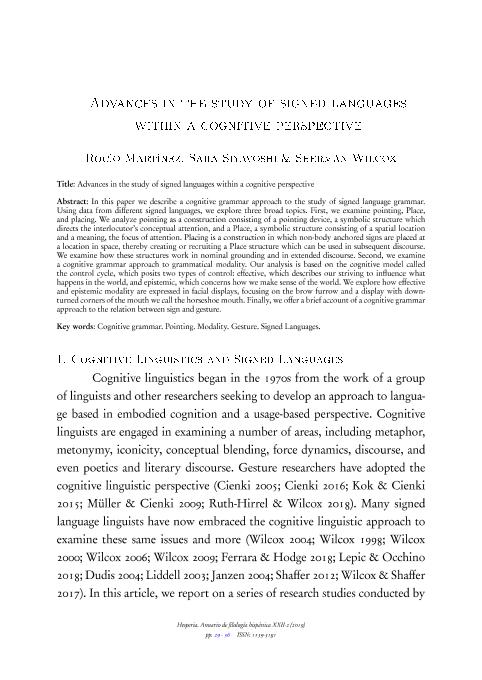Mostrar el registro sencillo del ítem
dc.contributor.author
Martínez, Rocío Anabel

dc.contributor.author
Siyavoshi, Sara
dc.contributor.author
Wilcox, Sherman
dc.date.available
2022-05-09T13:53:02Z
dc.date.issued
2020-03
dc.identifier.citation
Martínez, Rocío Anabel; Siyavoshi, Sara; Wilcox, Sherman; Advances in the study of signed languages within a cognitive perspective; Universidad de Vigo; Hesperia; 22; 3-2020; 29-56
dc.identifier.issn
1139-3181
dc.identifier.uri
http://hdl.handle.net/11336/156900
dc.description.abstract
In this paper we describe a cognitive grammar approach to the study of signed language grammar. Using data from different signed languages, we explore three broad topics. First, we examine pointing, Place, and placing. We analyze pointing as a construction consisting of a pointing device, a symbolic structure which directs the interlocutor?s conceptual attention, and a Place, a symbolic structure consisting of a spatial location and a meaning, the focus of attention. Placing is a construction in which non-body anchored signs are placed at a location in space, thereby creating or recruiting a Place structure which can be used in subsequent discourse. We examine how these structures work in nominal grounding and in extended discourse. Second, we examine a cognitive grammar approach to grammatical modality. Our analysis is based on the cognitive model called the control cycle, which posits two types of control: effective, which describes our striving to influence what happens in the world, and epistemic, which concerns how we make sense of the world. We explore how effective and epistemic modality are expressed in facial displays, focusing on the brow furrow and a display with down-turned corners of the mouth we call the horseshoe mouth. Finally, we offer a brief account of a cognitive grammar approach to the relation between sign and gesture.
dc.format
application/pdf
dc.language.iso
eng
dc.publisher
Universidad de Vigo
dc.rights
info:eu-repo/semantics/openAccess
dc.rights.uri
https://creativecommons.org/licenses/by-nc-nd/2.5/ar/
dc.subject
COGNITIVE GRAMMAR
dc.subject
POINTING
dc.subject
MODALITY
dc.subject
GESTURE
dc.subject
SIGNED LANGUAGES
dc.subject.classification
Lingüística

dc.subject.classification
Lengua y Literatura

dc.subject.classification
HUMANIDADES

dc.title
Advances in the study of signed languages within a cognitive perspective
dc.type
info:eu-repo/semantics/article
dc.type
info:ar-repo/semantics/artículo
dc.type
info:eu-repo/semantics/publishedVersion
dc.date.updated
2022-05-02T17:16:17Z
dc.journal.volume
22
dc.journal.pagination
29-56
dc.journal.pais
España

dc.journal.ciudad
Vigo
dc.description.fil
Fil: Martínez, Rocío Anabel. Consejo Nacional de Investigaciones Científicas y Técnicas; Argentina. Universidad de Buenos Aires. Facultad de Filosofía y Letras. Instituto de Lingüística; Argentina
dc.description.fil
Fil: Siyavoshi, Sara. University of New Mexico; Estados Unidos
dc.description.fil
Fil: Wilcox, Sherman. University of New Mexico; Estados Unidos
dc.journal.title
Hesperia
dc.relation.alternativeid
info:eu-repo/semantics/altIdentifier/url/https://revistas.webs.uvigo.es/index.php/AFH/article/view/1654
dc.relation.alternativeid
info:eu-repo/semantics/altIdentifier/doi/http://dx.doi.org/10.35869/hafh.v22i0.1654
Archivos asociados
